Rooms 5 and 6
These rooms were built (back to back) over the Collegio del Cambio at some time after 1473.
Room 5
This room contains a number of altarpieces that were painted for Perugian churches in the early 15th century by artists from Siena.
Panels from a polyptych (1403)
This double-sided polyptych, which is signed by Taddeo di Bartolo and dated by inscription, replaced an earlier polyptych on the high altar of San Francesco al Prato. The “new” polyptych was probably dismantled in 1536, the date at which the altar was moved backwards into the apse and re-consecrated. The individual panels were moved to the sacristy and then transferred to the Accademia di Belle Arti in 1810. The panels of SS Peter and Paul were taken to the Musei Capitolini, Rome in 1812 but returned to Perugia in 1817.
Modern scholarship has revealed that the polyptych originally comprised seven vertical planks, each of which was painted on both sides and each side of which had images in three registers. These planks were subsequently split into the 42 individual images.
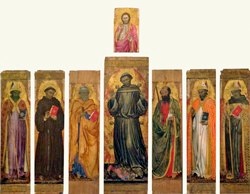
The seven panels from the central register of the side that faced the retro-choir are all exhibited here. They depict:
-
✴St Francis in a mandorla borne by angels, displaying all five wounds of his stigmatisation and crushing Lust, Power and Greed (in the central panel);
-
✴SS Herculanus, Antony of Padua and Peter (on the left); and
-
✴SS Paul, Constantius and Louis of Toulouse (on the right).
The whereabouts of two other panels that probably came from this side of the polyptych are known:
-
✴The panel from the centre of the upper register that depicts Christ displaying his wounds found its way to the gallery separately from the others.
-
✴A small panel in the Musée du Louvre, Paris that depicts of the Crucifixion with St Francis at the foot of the cross, possibly came from the central part of the predella.
The placing of these two panels respectively above and below the central panel of St Francis displaying his wounds constitutes one of the earliest depictions of him as "alter Christus" (the second Christ).
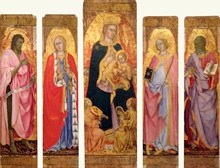
The inner five of the seven panels from the main register of the side that faced the congregation are also exhibited here. They depict:
-
✴the Madonna and Child with musical angels (in the central panel);
-
✴SS John the Baptist and Mary Magdalene (on the left); and
-
✴SS Catherine of Alexandria and John the Evangelist (on the right).
Two other panels from this side also survive:
-
✴The figure of St Elizabeth of Hungary, which came from the extreme right of the main register, is now in the Perkins collection in the Museo del Tesoro di San Francesco, Assisi.
-
✴The figure of Christ blessing, which came from the upper register of the central panel, is now in the Yale University Art Gallery, New Haven, Connecticut.
Six small panels of scenes from the life of St Francis in the Niedersächsischen Landesgallerie, Hannover and a seventh in the Van Heek Collection, Heerenberg, Holland came from the predella.
Pentecost (1403)
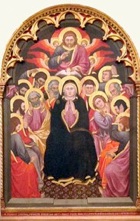
The upper part of the panel depicts God the Father sending the Holy Spirit in the form of a dove to the Virgin and Apostles assembled below.
Annunciation (ca. 1410)
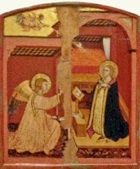
Panels from a polyptych (ca. 1410)
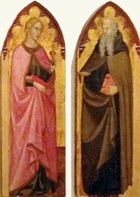
-
✴the central panel of the Madonna and Child, which is in the Princeton University Art Museum; and
-
✴a side panel depicting St Savinus, which is now in the Musée du Louvre, Paris.
Polyptych (1438)
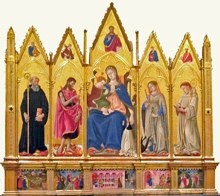
The inscription records that the Abbess Antonia di Francesco Buccoli commissioned this polyptych from Domenico di Bartolo in 1438. It was transferred from the choir of Santa Giuliana to the gallery in 1863.
The altarpiece is in the form of a conventional polyptych, but the use of triangular gables above the main panels seems to pay homage to the format of work that it probably replaced on the high altar: the dossal (1291) by Vigoroso da Siena (Room 2).
-
✴The central panel depicts the Madonna and Child, with Christ blessing in the gable above. The Abbess Antonia di Francesco Buccoli is shown kneeling before the Madonna and Child.
-
✴The other main panels depict (from the left):
-
•St Benedict, with St Peter in the gable above;
-
•St John the Baptist, with the angel of the Annunciation in the gable above;
-
•St Juliana of Nicomedia (with a winged dragon), with the Virgin Annunciate in the gable above; and
-
•St Bernard, with St Paul in the gable above.
-
The iconography of St Juliana is striking: she is often depicted leading a winged demon by a chain, but in this case the chain seems to be attached to her navel through a hole in her gown.
-
✴The predella panels , which depict scenes from the life if St John the Baptist, constitute one of the earliest surviving examples of the use of perspective in painting in the city.
Madonna and Child (ca. 1410)

Room 6
This room contains works from the early 15th century, many of which betray the influence if the International Gothic style.
Pietralunga Polyptych (1403)
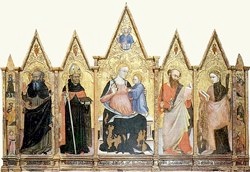
The inscription records that the heirs of Pietro Corsutio commissioned this polyptych from Ottaviano Nelli in 1403. It was discovered in the loft of the church of Sant' Agostino, Pietralunga in 1896 and transferred to the Palazzo Comunale, Gubbio. It was acquired by the gallery in 1954.
The central panel depicts the Madonna and Child enthroned. The other panels depict:
-
✴SS Antony Abbot and Augustine (to the left); and
-
✴SS Paul and Catherine of Alexandria (to the right).
The gable above the Madonna and Child contains a three-headed representation of the Trinity, while the corresponding figures in the other gables are Seraphim.
The polyptych is described in more detail in the website of the Commune of Pietralunga.
Madonna and Child (ca. 1410)
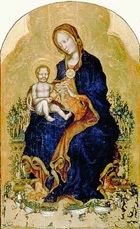
There is no surviving documentation that relates to the panel until 1861, when it was in the chapel of the Novitiate, inside the convent. It entered the gallery in 1863. Maria Rita Silvestrelli (see the page on the artist) has suggested that it was originally in the Cappella di San Giacomo (now the sacristy) and that its frame bore the arms of the Graziani family.
The panel, which has been cropped at the sides and cut down at the top, was clearly originally in a trefoil frame. It might originally have been the central panel of a triptych or polyptych, but the fact that Vasari mentioned only this panel suggests that, if so, the work had already been broken up by the 16th century. Nothing is known of any other components, if indeed they did exist.
The form of the original frame suggests that the panel was painted in Venice. Its iconography is emphatically Marian:
-
✴The Virgin is seated on a throne that is covered with vegetation, which was probably conceived as the hortus conclusus (enclosed garden, a symbol of virginity).
-
✴Three pairs of angels are stippled into the golden background: one pair crowns the Virgin while the other four angels present her with lilies (symbols of purity).
-
✴Seven tiny angels (now very damaged) hold a scroll inscribed with the antiphon Regina Coeli (Queen of Heaven).
-
✴Other inscriptions in the Virgin’s halo and along the edge of her cloak add further praise.
-
✴The Virgin presents the Child with a pomegranate (the symbol of the Resurrection).
This was one of the first examples of what is now called International Gothic art to appear in Perugia. The fine workmanship of the golden background was fully revealed by the restoration carried out in 1994.
Panels from a Polyptych (early 15th century)

In 1791, Baldassare Orsini recorded the presence of these five panels in Sant’ Agostino. He also reported that:
-
✴two associated predella panels, which depicted the Crucifixion and the martyrdom of St Sebastian, were separately displayed; and that
-
✴the work came from San Benedetto dei Condotti (previously Santa Maria Novella).
The scroll at the foot of the throne in what was the central panel identifies the artist as Lello da Velletri.
It seems reasonable to suppose that the panels came from a polyptych that the hermits from Montemable commissioned for the high altar soon after they moved to Santa Maria Novella in 1421. They probably took the panels to Sant' Agostino in 1641, when Santa Maria Novella was ceded to the Sylvestrines. The main panels entered the gallery in 1863, by which time the predella panels had been lost.
All five panels are set in a flowery meadow, and each has a gold background:
-
✴The central panel depicts the Madonna and Child enthroned with two kneeling angels. The Madonna offers a small bunch of red and white flowers to the Child, signifying the Crucifixion.
-
✴The other panels depict saints whose identities are recorded by inscriptions in the haloes:
-
•St Augustine, whose Rule was followed by the Augustinian hermits;
-
•St John the Baptist, who probably commemorated Fra Battista da Gubbio, the prior who commissioned Santa Maria Novella and whose death possibly preceded the commission of the altarpiece;
-
•St Liberatore, who probably commemorated Fra Liberato di Simone, a monk from the earlier monastery on Montemalbe who was murdered in 1391; and
-
•St Agatha, who holds her severed breasts on a plate.
Crucifixion (ca. 1410)
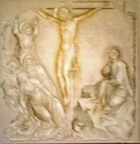
-
✴the swooning Virgin, the distraught St Mary Magdalene and other women to the left; and
-
✴the weeping St John the Evangelist on a rock to the right.
[Note that the attribution and dating here are suggested by Mauro Minardi, cited on the page on the artist. The gallery dates the work to ca. 1416-20 and attributes it to Lorenzo’s brother, Jacopo Salimbeni.]
Galleria Nazionale: Sala Podiani and Sala Conferenze Rooms 1-3 Room 4
Rooms 5-6 Rooms 7-10 Rooms 11-16 Room 17 Rooms 18-20 Cappella dei Priori
Rooms 22-28 Rooms 29-32 Rooms 33-40 Deposit
Return to Museums of Perugia.
Return to Walk I.



